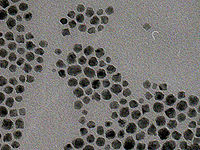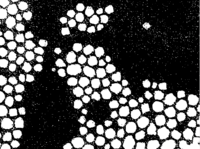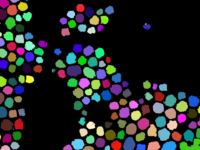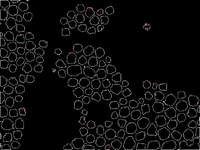Difference between revisions of "Example Binary Image"
From BoofCV
Jump to navigationJump to searchm |
m |
||
| (4 intermediate revisions by the same user not shown) | |||
| Line 10: | Line 10: | ||
In a binary image each pixel can have a value of 0 or 1. Binary images are easy to compute and fast to process, which makes them popular in many applications. BoofCV contains many operations for creating and manipulating binary images. The example below demonstrates a few of ones contained inside of BinaryImageOps. | In a binary image each pixel can have a value of 0 or 1. Binary images are easy to compute and fast to process, which makes them popular in many applications. BoofCV contains many operations for creating and manipulating binary images. The example below demonstrates a few of ones contained inside of BinaryImageOps. | ||
Example File: [https://github.com/lessthanoptimal/BoofCV/blob/v0. | Example File: [https://github.com/lessthanoptimal/BoofCV/blob/v0.40/examples/src/main/java/boofcv/examples/imageprocessing/ExampleBinaryOps.java ExampleBinaryOps.java] | ||
Concepts: | Concepts: | ||
| Line 18: | Line 18: | ||
* Pixel Math | * Pixel Math | ||
* Image Rendering | * Image Rendering | ||
= Basic Example = | = Basic Example = | ||
| Line 29: | Line 25: | ||
* then extracting detected features by finding their contours. | * then extracting detected features by finding their contours. | ||
* | * | ||
* @author Peter Abeles | |||
* @see boofcv.examples.segmentation.ExampleThresholding | * @see boofcv.examples.segmentation.ExampleThresholding | ||
*/ | */ | ||
public class ExampleBinaryOps { | public class ExampleBinaryOps { | ||
public static void main( String[] args ) { | |||
public static void main( String | |||
// load and convert the image into a usable format | // load and convert the image into a usable format | ||
BufferedImage image = UtilImageIO. | BufferedImage image = UtilImageIO.loadImageNotNull(UtilIO.pathExample("particles01.jpg")); | ||
// convert into a usable format | // convert into a usable format | ||
GrayF32 input = ConvertBufferedImage.convertFromSingle(image, null, GrayF32.class); | |||
var binary = new GrayU8(input.width, input.height); | |||
var label = new GrayS32(input.width, input.height); | |||
// Select a global threshold using Otsu's method. | // Select a global threshold using Otsu's method. | ||
| Line 48: | Line 42: | ||
// Apply the threshold to create a binary image | // Apply the threshold to create a binary image | ||
ThresholdImageOps.threshold(input,binary,(float)threshold,true); | ThresholdImageOps.threshold(input, binary, (float)threshold, true); | ||
// remove small blobs through erosion and dilation | // remove small blobs through erosion and dilation | ||
// The null in the input indicates that it should internally declare the work image it needs | // The null in the input indicates that it should internally declare the work image it needs | ||
// this is less efficient, but easier to code. | // this is less efficient, but easier to code. | ||
GrayU8 filtered = BinaryImageOps.erode8(binary, 1, null); | |||
filtered = BinaryImageOps.dilate8(filtered, 1, null); | filtered = BinaryImageOps.dilate8(filtered, 1, null); | ||
| Line 70: | Line 64: | ||
input.width, input.height, null); | input.width, input.height, null); | ||
var panel = new ListDisplayPanel(); | |||
panel.addImage(visualBinary, "Binary Original"); | panel.addImage(visualBinary, "Binary Original"); | ||
panel.addImage(visualFiltered, "Binary Filtered"); | panel.addImage(visualFiltered, "Binary Filtered"); | ||
panel.addImage(visualLabel, "Labeled Blobs"); | panel.addImage(visualLabel, "Labeled Blobs"); | ||
panel.addImage(visualContour, "Contours"); | panel.addImage(visualContour, "Contours"); | ||
ShowImages.showWindow(panel,"Binary Operations",true); | ShowImages.showWindow(panel, "Binary Operations", true); | ||
} | } | ||
} | } | ||
</syntaxhighlight> | </syntaxhighlight> | ||
Latest revision as of 14:57, 17 January 2022
- Example input and output Images
In a binary image each pixel can have a value of 0 or 1. Binary images are easy to compute and fast to process, which makes them popular in many applications. BoofCV contains many operations for creating and manipulating binary images. The example below demonstrates a few of ones contained inside of BinaryImageOps.
Example File: ExampleBinaryOps.java
Concepts:
- Image Thresholding
- Morphological Operations
- Binary Labeling
- Pixel Math
- Image Rendering
Basic Example
/**
* Demonstrates how to create binary images by thresholding, applying binary morphological operations, and
* then extracting detected features by finding their contours.
*
* @author Peter Abeles
* @see boofcv.examples.segmentation.ExampleThresholding
*/
public class ExampleBinaryOps {
public static void main( String[] args ) {
// load and convert the image into a usable format
BufferedImage image = UtilImageIO.loadImageNotNull(UtilIO.pathExample("particles01.jpg"));
// convert into a usable format
GrayF32 input = ConvertBufferedImage.convertFromSingle(image, null, GrayF32.class);
var binary = new GrayU8(input.width, input.height);
var label = new GrayS32(input.width, input.height);
// Select a global threshold using Otsu's method.
double threshold = GThresholdImageOps.computeOtsu(input, 0, 255);
// Apply the threshold to create a binary image
ThresholdImageOps.threshold(input, binary, (float)threshold, true);
// remove small blobs through erosion and dilation
// The null in the input indicates that it should internally declare the work image it needs
// this is less efficient, but easier to code.
GrayU8 filtered = BinaryImageOps.erode8(binary, 1, null);
filtered = BinaryImageOps.dilate8(filtered, 1, null);
// Detect blobs inside the image using an 8-connect rule
List<Contour> contours = BinaryImageOps.contour(filtered, ConnectRule.EIGHT, label);
// colors of contours
int colorExternal = 0xFFFFFF;
int colorInternal = 0xFF2020;
// display the results
BufferedImage visualBinary = VisualizeBinaryData.renderBinary(binary, false, null);
BufferedImage visualFiltered = VisualizeBinaryData.renderBinary(filtered, false, null);
BufferedImage visualLabel = VisualizeBinaryData.renderLabeledBG(label, contours.size(), null);
BufferedImage visualContour = VisualizeBinaryData.renderContours(contours, colorExternal, colorInternal,
input.width, input.height, null);
var panel = new ListDisplayPanel();
panel.addImage(visualBinary, "Binary Original");
panel.addImage(visualFiltered, "Binary Filtered");
panel.addImage(visualLabel, "Labeled Blobs");
panel.addImage(visualContour, "Contours");
ShowImages.showWindow(panel, "Binary Operations", true);
}
}



